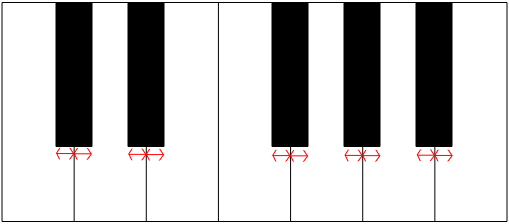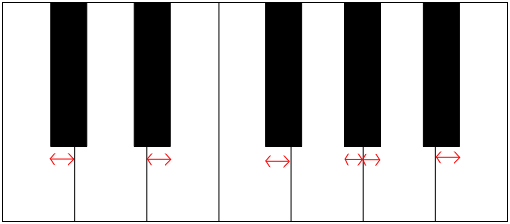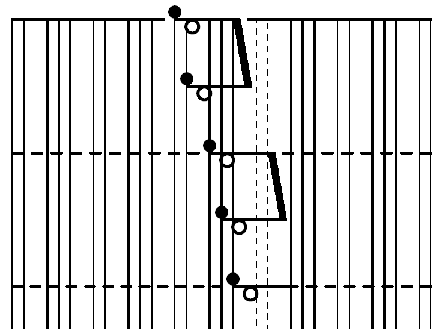It’s like meeting for the first time…
Tonight I was practicing reading Klavarskribo on my acoustic piano. It’s amazing how much this notation is transforming how I think about the keyboard. All the irregularities of the piano keyboard layout are jumping out at me like they never have before. I’m paying attention to the physical piano keys and their relationship to each other. I’m astonished (and embarrassed to admit) that, after having studied piano since the age of 6, I never consciously noticed (at least as far as I can remember) that four out of five of the black keys are not placed exactly in the middle between their two adjacent white keys. In fact, I unconsciously perceived them the way that Klavarskribo depicts them, spaced equidistantly from their adjacent white keys:

In actuality, they’re spaced out from each other so that the black keys aren’t too close to each other and so there’s not such a big gap between the two groups of black keys:

The difference is subtle, but you can definitely feel it. It’s what accounts for the fact that the minor 3rd starting on A-flat feels a bit bigger than the Major 2nd starting on B-flat. Of course, in my theory-ridden brain, I naturally assume that a 3rd would feel bigger than a 2nd, because it’s a bigger interval. But no, it’s not because it’s a bigger interval, it’s because of the irregularity of the keyboard. In truth, I think the difference in distance feels bigger than it really is, because I’ve been trained to think that it’s a bigger interval. In actuality, they are physically quite similar, and if my unconscious assumption that the black keys were placed equidistant from their adjacent white keys had been true, they would be physically exactly the same.
In Klavarskribo notation, they are physically exactly the same distance from each other:

The above intervals are visually and (at least approximately) physically equivalent. Yet they’re not the same intervals. They are: m3 (minor third), M2 (major second), m3, m3, M2. But if you’re learning Klavarskribo, which makes you very attentive to the keyboard layout, you would recognize these as physically equivalent. They almost seem worth naming (“BWW”, for black-white-white?), at least perhaps as a way of organizing a series of Klavarskribo exercises. After forging the visual-kinesthetic link, you can then start layering on the theory that recognizes that, although these intervals look and feel the same, they are in fact different.
So while Klavarskribo glosses over the slight physical irregularities of the piano keyboard, traditional notation completely abstracts away from the physical characteristics of the keyboard. I’m not saying that’s a bad thing. I just want to clearly see this difference. I do find it terribly odd how unfamiliar I am with the keyboard after so many years of practice and study. And I’m struck how I have to keep saying “physical keys” just to distinguish which meaning of the overloaded term “key” I’m intending. It’s almost like the language of theory is rigged to detract attention from the physicality and irregularities of the instrument. The word “key” tends to mean “tonal center,” and my musically-trained brain keeps gravitating back toward that usage.
In any case, Klavarskribo is a much more raw representation of notes to play on the keyboard, and I’m liking it for that and for the fresh insights it’s giving me.
Joe said,
July 14, 2008 @ 4:47 pm
Evan,
I’ve also discovered Klavarskribo and am curious whether there are other fans or music sources in the US.
Also, do you know of an English tutorial on the KlavarScript software?